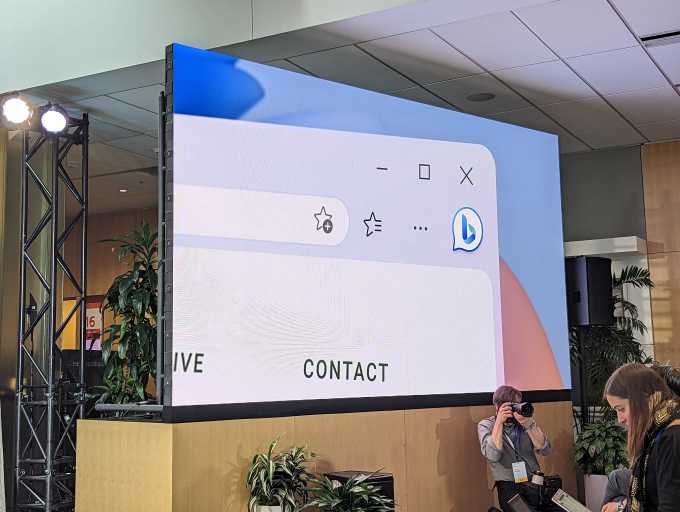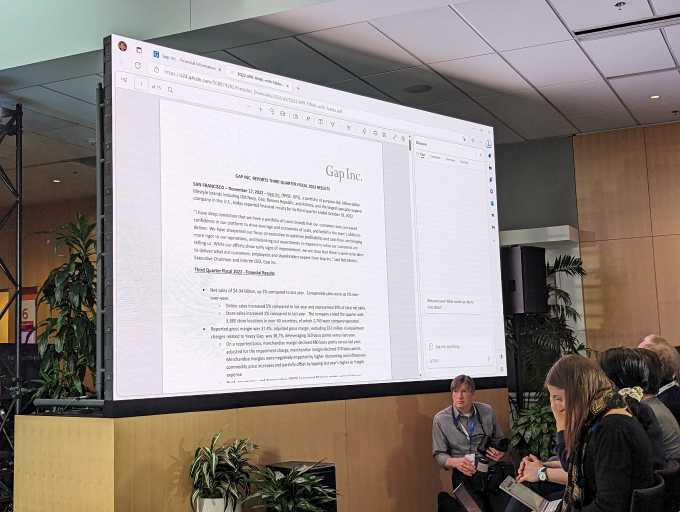At a Microsoft press event today where the company demonstrated its new A.I.-powered search capabilities in Bing, the company also announced a new version of its Edge web browser that includes A.I. technologies built-in. With the new browser, web users are able to do things like summarize search results with A.I.’s help and converse with A.I. chatbots to get their questions answered, among other things.
“It’s sleeker, it’s lighter,” said Yusuf Mehdi, Microsoft Corporate VP, when demonstrating the new version of the browser, which now sports a few aesthetic changes, like rounded corners.
Similar to the updates coming to Bing, an A.I. chatbot is available in a sidebar in Edge and includes two functionalities at launch: chat and compose.

Image Credits: Microsoft event photo via TechCrunch
These can be combined to help users do things like summarize lengthy web content, run comparisons, or even create content, in some cases.
Mehdi showed off how Edge’s A.I. powers could be put to use in a handful of demos during the event. In one, he visited the Gap website to look up the quarterly reports and earnings. He clicks a link to view the Q3 report and it pulls up a 15-page PDF.
“It’s pretty long. I won’t have time to read all that. What I’d love is a summary of the key points,” he says.
Then, with a click, he opens up a chatbot from the top of the browser and asks it to give him the most important takeaways from the page. The A.I. returns a summary promptly, representing a “massive time savings,” Mehdi notes.
What’s more impressive, however, is what the A.I. does next. He has it compare the Gap Q3 financials to Lululemon’s Q3 and make a table with its findings.

Image Credits: Microsoft event photo via TechCrunch
In another demo, he showed off how the A.I. could be used alongside the developer resources on the Stack Overflow website. He shows how a developer who was researching tips on how to parse a JSON file finds a code snippet they want to use. But the code is in Python and the developer wants it in Rust.
To get help with this from the A.I., Mehdi highlights the text which then brings it up in Edge’s new sidebar, then instructs the A.I. to write the code in Rust. It does.
In a final example, Mehdi demonstrates using the A.I. in the sidebar to write a LinkedIn post. (And you thought the corporate posts sounded like bots now!).
In this case, he gives the A.I. a few prompts to get it started. You can also ask to refine the post by tone, format, or length, and Edge understands and updates the draft accordingly.
The news about Edge was announced alongside the anticipated arrival of OpenAI’s technologies in the Bing search engine, following Microsoft’s $1 billion investment into OpenAI. At the event, Microsoft revealed how it integrated OpenAI’s GPT-4 model into its search engine to provide users with a ChatGPT-like experience. Except in Bing’s case, the A.I. isn’t limited only to data covering up to 2021 — it’s capable of handling queries related to more recent events.
Alongside these A.I. updates to Bing, the updated Edge browser will be available to preview today.
“AI will fundamentally change every software category, starting with the largest category of all – search,” said Satya Nadella, Microsoft Chairman and CEO, in an announcement. “Today, we’re launching Bing and Edge powered by AI copilot and chat, to help people get more from search and the web.”
Microsoft adds built-in A.I. capabilities to its Edge web browser by Sarah Perez originally published on TechCrunch















 English (US) ·
English (US) ·